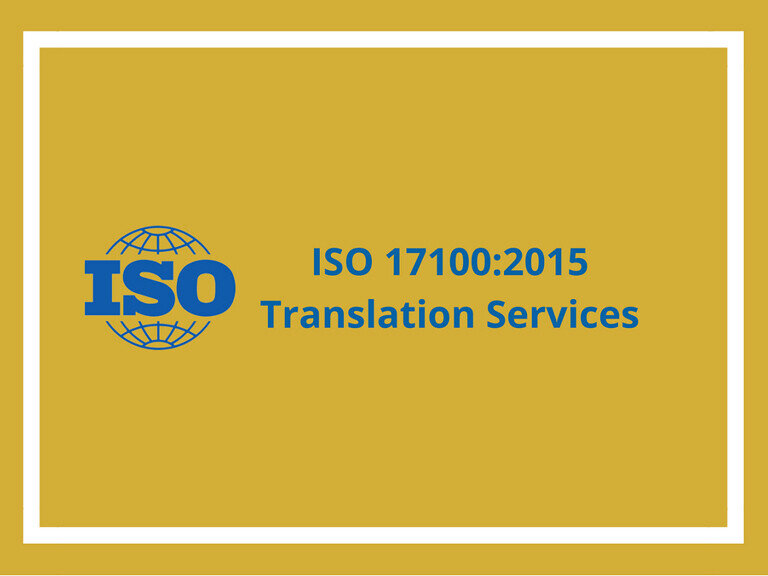With the widespread of contents in various languages on the Internet, the role of machine translation (MT) is a sure thing. However, this has resulted in many people’s lowered respect for human translation work. This poses a great challenge to human translators who want to demonstrate their capabilities and excellent translation quality in comparison with MT translation. Perhaps we should find out what is a professional translation process according to ISO 17100:2015 to understand how many steps and efforts it takes to deliver a quality human translation.
ISO 17100:2015 Translation Services-Requirements for Translation Services is the very first ISO standard on translation services, published on May 01, 2015. It is based on EN 15038, a quality standard developed earlier for translation services providers by the European Committee for Standardization (CEN). This was an overall attempt of many associations and bodies to seek for an universal quality standard that could benchmark the quality of translation services as well as gain recognition through independent audit certification.
Contents on translation process are specified in Clause 5.3. Following which, there is a total of 6 steps for a full translation process. As you can see, the translators are demanded more efforts than merely translation!
Step 1: Translation
In this first step, the translator shall translate in accordance with the purpose of the translation project, including the linguistic conventions of the target language and relevant project specifications. Throughout this process, the translator shall provide a service conforming to this International Standard with regards to the following:
- compliance with specific domain and client terminology and/or any other reference material provided and ensuring terminological consistency during translation;
- semantic accuracy of the target language content;
- appropriate syntax, spelling, punctuation, diacritical marks, and other orthographical conventions of the target language;
- lexical cohesion and phraseology;
- compliance with any proprietary and/or client style guide (including domain, language register, and language variants);
- locale and any applicable standards;
- formatting;
- target audience and purpose of the target language content.
The translator shall raise any uncertainty as a query with the project manager. This is an important requirement for any translator in this very first step. It helps the project manager to be able to properly aware of issues incurred during the project implementation, thus tackling or searching for solutions against thereof, eliminating risks of non-conformities in the translation. To guarantee this requirement, an awareness training should be conducts among all the participating translators and the project manager. Besides, an internal communication model should also be established to smooth flow of information.

Step 2: Translation Check
This task shall at least include the translator’s overall self-revision of the target content for possible semantic, grammatical and spelling issues, and for omissions and other errors, as well as ensuring compliance with any relevant translation project specifications. The translator shall make any corrections necessary prior to delivery.
The translators should bear in mind that their products out of these first 2 steps must be the work of their best effort. One should not think that as my translation would be checked any way, so minor mistakes sure gonna be corrected. This kind of irresponsible thinking may lead to huge potential of mistakes and cost to fix it. Instead, one should think that I will try my best to do the translation. That translation should be readily available for use upon delivery!
Step 3: Revision
In this step, the translation service provider (TSP) shall ensure that the target language content is revised. The reviser, who shall be a person other than the translator, shall have the competences required in the source and target languages. The reviser shall examine the target language content against the source language content for any errors and other issues, and its suitability for purpose. This shall include comparison of the source and target language content for the aspects listed in the first step.
As agreed upon with the project manager, the reviser shall either correct any errors found in the target language content or recommend the corrections to be implemented by the translator. It is also noted that corrections can include retranslation. Any errors or other issues affecting target language content quality should be corrected and the process repeated until the reviser and TSP are satisfied. The reviser shall also inform the TSP of any corrective action he/she has taken.
This step ensures 4-eyes principle. Although the translator may have translated at his best, mistakes still occur due to subjective reasons. Especially in the self-revision, we tend to skip what we think is not important or what we think we have checked really carefully. Another person will help to easily find out such skips, not mentioning his/her speciality. The corrections can then be performed by the reviser or the translator, depending on the time availability, project’s requirements or own choice of the project manager. However, in any cases, the translators should be notified about their errors for them to avoid such in the future. This helps ensure continued improvement.
Step 4: Review
The TSP shall require the reviewer to carry out a review to assess the suitability of the target language content for the agreed upon purpose and domain and recommend corrections to be implemented by the TSP. The TSP can instruct the reviewer to make corrections. The review includes assessing domain accuracy and respect for the relevant text-type conventions.
Thanks to the development of technology, the reviewer now has firm choice of applications to help perform the reviewing task. It includes segment sampling or QA tools such as Xbench.
Step 5: Proofreading
If the client-TSP agreement and project specifications include proofreading, the TSP shall ensure that this service is provided. Where the proofreading reveals defects, the TSP shall make corrections and take appropriate action to remedy these defects.
Step 6: Final verification and release
The TSP shall have a process in place for final verification of the project against specifications by the Project Manager (PM) before delivery to the client. After final verification and delivery, the TSP should have a process for invoicing and payment procedures. If the final verification indicates any defects in meeting specifications, the TSP shall make corrections and take corrective action as appropriate.
This 6-step process is a guarantee that a translation is converted thoroughly from source to target language and that all efforts have been made to ensure accuracy, appropriateness and avoidance of unintentional mistakes. Besides, there is also a post-production process for client feedback and taking corrective actions, if any. At this point, one should clearly see that MT is just a minor step at the beginning of the whole translation process. It comes as input, a draft translation, for translators. However, the more steps you take, the higher the cost. Clients can base on this to evaluate whether the translations they get back are commensurate with what they spend.
As a professional language service provider, AM Vietnam prides ourselves on adhering to international standards covering the full 6-step standard operating procedure. In addition, for those requiring perfect quality, we also have in place a plus step of Expert review. In Expert review, the translation will be ensured in terms of technical terminology and language use by our leading experts, who have practical expertise and at least 10-year experience in the relevant field.
Click here to get a quick reference to ISO 17100:2015!
Or continue to enjoy reading the latest news and updates on Language Service Solutions here.







